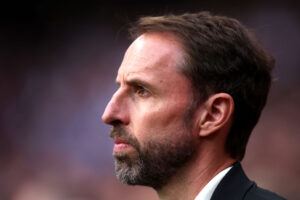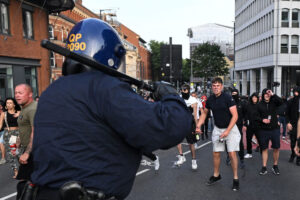If riots are an expression of masculinity, then warnings about the return of the Football League at the weekend were perhaps inevitable. The season’s first game was scheduled to the place in Middlesbrough, where marauding rioters had torched cars the week before. Keir Starmer himself, no stranger to the terraces, acknowledged that football had been “added into the mix” of the police’s plans to handle future disorder.
Yet as it happened, fears about an orgy of racist violence proved unfounded. It may even be, as a couple of official bodies acknowledged privately, that the return of football helped mitigate the threat of further discord.
It might seem flippant to suggest that there’s no time to riot when you’ve got Coventry away, but the links between football and the far-Right can’t be denied. The English Defence League (EDL) emerged in March 2008 when a group calling itself the United People of Luton organised against local Muslims protesting the return of troops from Afghanistan. Common cause was found with various hooligan firms associated with football clubs, and by the summer there were EDL branches run by firms across the country.
This sporting symbiosis is not unusual, and certainly not unique to Britain. For those seeking to deploy bodies on the streets, hooligan groups are enormously useful: they are organised, have a clear leadership structure and are used to fighting the police. In 1997, for instance, when the mayor of Cacak, Velja Iljic, led the march on Belgrade that culminated in the toppling of Slobodan Milosevic, he was joined by the Delije, the hardcore fans of Crvena Zvezda who had formed the core of Arkan’s troops during the civil war. In Argentina, meanwhile, the barras bravas football gangs have essentially become muscle for hire.
Even so, it would be wrong to see Britain’s recent riots as eruptions of football hooliganism — or at least to see them purely as such. As Metropolitan police commissioner Sir Mark Rowley said last week, while some of those who have been convicted have football banning orders, around 70% “have previous convictions for weapon possession, violence, drugs and other serious offences”.
Rowley spoke of “thugs and criminals”, but there is a sense of groups intersecting. The riot in Sunderland came the night before three skinhead bands were scheduled to play in the city at a “Blood and Honour” gig which, according to Hope Not Hate, drew neo-Nazis from as far away as Stoke-on-Trent. A sense of being left behind seems to play a part: according to the Government’s Indices of Deprivation, seven of the 10 most deprived towns in the UK have witnessed riots, although it may be that Right-wing groups have targeted those areas rather than the violence being a spontaneous outbreak of despair or nihilism. Covid vaccine-scepticism seems to have radicalised another tranche of society, sending them into the orbit of the far-Right.
But it’s also the case that some find rioting intoxicating. Talking to hooligans in Eastern Europe for my book Behind the Curtain, a recurring theme was how many just enjoyed fighting: it wasn’t a by-product or a means to an end; the fighting was the point. In a Czech bar near Moscow Zoo, I met Oleg, a heavyset member of a Spartak firm in his forties. “The best thing,” he explained, “is fighting with police in other countries. You throw things at them and then they run at you and you fight.” This is also one of the key insights of the US academic Bill Buford’s 1991 book Among the Thugs: for some, violence is fun.
The easy mistake is to see far-Right attitudes as characteristic of football. Given how violence has largely been eliminated from stadiums, it’s debatable to what extent the remaining hooligan groups can even be considered a football problem. The yob fan was always a lazy and misleading stereotype, even in the days when stands were urine-stained theatres of violence, neo-Nazis a visible presence at games and racist chanting commonplace. Leeds United fans, for instance, ran a successful campaign against the National Front in the late Eighties, based around the fanzine Marching on Together. Today, Britain’s most influential national football campaign is arguably Kick It Out.
In reality, football has always been too big to be defined by one outlook alone. Rather, particularly in post-industrial provincial cities, it has become a signifier of a place’s identity. If, say, Sunderland or Leicester are thought of at all by the wider population these days, it tends to be in the context of football. Even large British cities are now best-known globally for football: ask a taxi driver in Beirut or Bangalore what he knows of Liverpool, and he’ll probably be aware of the Beatles but will almost certainly have heard of Mohamed Salah.
That gives football a curiously powerful role that still hasn’t been fully appreciated. Take the Indices of Deprivation: of the 12 most deprived towns in its list that have suffered riots — Middlesbrough, Blackpool, Liverpool, Hartlepool, Hull, Manchester, Blackburn, Nottingham, Sunderland, Stoke, Bolton — only Hartlepool has not had a Premier League club in the past two decades.
And perhaps this shouldn’t come as a surprise. For all that it’s gentrified over the past 30 years, for all the glamour at the elite level of the game, for all the domination by overseas investment, football remains the great sport of the industrial heartlands. When there is nothing else, with churches, trade unions, even political parties in retreat, football becomes pretty much the only marker of identity. If you were an agitator wishing to gain ready acceptance in one of those towns, the easiest way would be to pull on the shirt of the local team.
That has led to a curious subtext over the past fortnight: the attempts to control the message of the shirt. While a handful of the rioters in Sunderland were wearing SAFC shirts, the following day a far greater proportion of those who volunteered for the clean-up were wearing them. It’s an issue of which the MP for Sunderland Central, Lewis Atkinson, who turned up for the clean-up in an away shirt from the Seventies, is acutely aware. “When I got dressed that morning,” he said, “I just knew I wanted to wear that shirt. To me it stemmed from a determination to not allow a minority of thugs to own the most precious identity in Sunderland, to show that it was those of us sweeping away the shards of hate who were the true Sunderland.”
The point here is that while there is a relationship between football and the far-Right, there is a stronger relationship between football clubs and their local communities — even as top-level clubs increasingly come to feel like quasi-global franchises. And those communities, as the clean-up operations and the anti-racism demonstrations have shown, are opposed to the riots.
At 11.19pm on the night of the riots in Sunderland, Sunderland AFC posted a message on X condemning the violence, saying it did not “represent our culture, our history, or our people. Our great city is built on togetherness and acceptance, and Sunderland will forever be for all.” This was a club not as an inadvertent projection of regional identity, but one embracing its role as a community leader. And in doing so, it confirmed something important: the rioting is not a football problem, but football has a role to play in the aftermath.
Disclaimer
Some of the posts we share are controversial and we do not necessarily agree with them in the whole extend. Sometimes we agree with the content or part of it but we do not agree with the narration or language. Nevertheless we find them somehow interesting, valuable and/or informative or we share them, because we strongly believe in freedom of speech, free press and journalism. We strongly encourage you to have a critical approach to all the content, do your own research and analysis to build your own opinion.
We would be glad to have your feedback.
Source: UnHerd Read the original article here: https://unherd.com/




